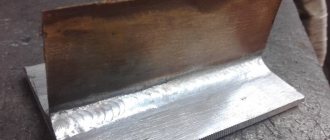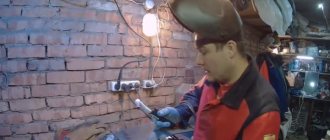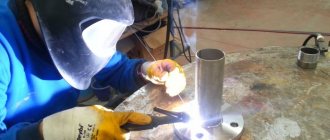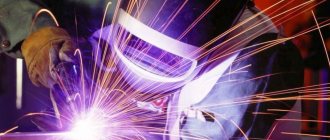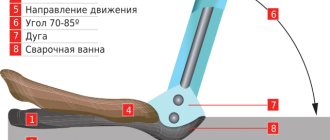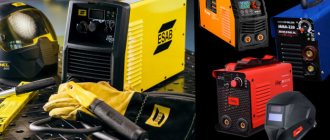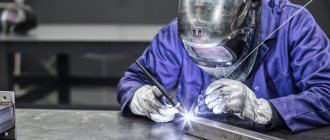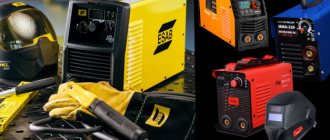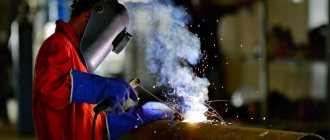The most effective way to create a permanent connection of parts made of aluminum and alloys based on this metal, as practice shows, is welding aluminum with argon. Any welding technology that involves the use of shielding gas requires the use of special equipment, as well as the welder having the appropriate knowledge, qualifications and experience in performing such work. In addition, it is necessary to have at least basic knowledge in the field of metallurgy in order to understand what processes take place in the weld pool.
Aluminum argon arc welding process
What properties of aluminum should be taken into account when welding it?
Understanding the nuances of the processes occurring in the structure of aluminum when performing welding work with it is especially important for novice welders. To understand this well, you need to become familiar with the chemical properties of this metal, which is characterized by its low specific gravity, high strength and exceptional chemical reactivity.
The most significant characteristic of aluminum, which not only experienced but also novice welders should know about, is its ability to quickly react with oxygen, which leads to the formation of a refractory oxide film on the surface of the metal. Typically, aluminum itself can melt at a temperature of 650 degrees, and to melt the oxide film covering its surface, a heating temperature exceeding 2000 degrees is required. When welding with direct current, the unmelted oxide film can be immersed in the molten metal, thereby deteriorating its internal structure.
Argon arc welding diagram
Another feature that should be taken into account when welding this metal is that it does not change its color when heated. Because of this, it is quite difficult to visually determine the degree of heating of the parts being joined, which often leads to burn-throughs and leakage of molten metal during welding.
A property of aluminum that should be taken into account if you are planning to weld parts from this metal is a significant coefficient of its volumetric shrinkage, which often leads to the occurrence of stresses and deformations inside the formed weld and, as a result, to the formation of cracks in it. To avoid such unpleasant consequences, it is necessary to modify the weld or compensate for metal shrinkage by using more welding wire.
Any instruction for welding aluminum, as well as alloys based on it, requires that the specialist performing it is aware of the characteristics of this metal, which include:
- high chemical activity;
- low melting point of the metal itself;
- significant volumetric shrinkage.
Considering all of the above, it can be argued that it is thanks to welding aluminum with argon that high-quality, beautiful and reliable connections of parts are obtained. And if you use semi-automatic equipment to perform such welding, you can effectively solve two problems at once: protect the welding zone from harmful environmental influences, and also compensate for significant metal shrinkage due to the constantly supplied welding wire.
Of course, in addition to this technology, there are other methods of joining aluminum parts using welding, the specifics of which every specialist should know about.
Modes of argon arc welding of aluminum and its alloys
Characteristics of filler rods
Argon arc welding can be carried out without the use of filler material, but the greatest effect is achieved only if it is used. This material is called filler rods for argon arc welding. From a rod design perspective, they are small, straight pieces of wire that form the basis of the weld.
Each rod, depending on its purpose, has its own composition and properties. This makes them similar to filler wire, which is used in conventional welding. The purpose of the additive is to weld dissimilar elements with argon, so it must fully comply with the characteristics of the material being welded.
During argon welding, filler rods are placed into the base of the weld.
Thus, the use of rods for argon welding must fulfill the following conditions:
- form a seam that is ideal in shape and structure;
- ensure anti-corrosion of the seam;
- create resistance to intracrystalline destruction.
In order to meet the stated requirements, the filler wire may consist entirely of one material or have cores of other alloys.
For example, rods for working with stainless steel are equipped with cores made of an alloy of chromium and nickel.
They are widely used in the construction of pipelines, in the food, chemical and oil industries, and in mechanical engineering.
Aluminum welding methods
In addition to welding, which involves the use of argon as a shielding gas, aluminum parts can be welded using other technologies. The most common are:
- welding performed using a gas torch;
- arc welding;
- argon arc welding.
The first of the above aluminum welding technologies involves the use of filler wire fed into the welding zone, as well as a special flux consisting of fluoride and chloride salts. The flux, which together with the filler rod is heated by the flame of a gas burner, corrodes the oxide film and opens the flame to the base metal, which melts at a fairly low temperature. After completing welding work performed using this technology, it is necessary to immediately wash the surfaces of the parts to be joined in order to wash off any remaining caustic flux from them. The great advantage of this technology is that its use ensures minimal consumption of filler material.
Equipment for semi-automatic welding in argon
To connect aluminum parts, an electric arc welding machine, special aluminum electrodes or filler wire coated with flux can also be used. Welding when using such a device is performed with direct current connected with reverse polarity.
However, as noted above, the highest quality connection can be obtained by argon arc welding of aluminum. When using this technology, heating of the parts to be joined is ensured by an electric arc burning between an infusible tungsten electrode and the workpieces being joined. The formation of a weld occurs through the use of aluminum wire fed into the arc combustion zone manually or mechanically - in semi-automatic welding.
Equipment for manual argon arc welding
The high temperature created when an electric arc burns makes it possible to destroy the oxide film on the surface of the parts being joined, and so that the aluminum does not have time to go into the liquid phase and leak out of the zone of the joint being formed, the welding electrode is moved at a fairly high speed. The big advantage of this welding method is that the electrode, made of refractory tungsten, lasts for a long time, and this allows you to save on consumables.
In order for a weld made semi-automatically using filler wire to have high quality and reliability, it is necessary that the chemical composition of such wire matches the composition of the workpieces being joined to the maximum extent possible.
To perform welding using this technology, today we use devices that generate direct or pulsed current, and there are also devices that use alternating current to weld.
Welding stainless steel pipes
Stainless steel pipes are increasingly used today in everyday life, although in industry they are used in large volumes and in many areas. Their joining, especially thin-walled pipelines, is carried out using argon arc welding. The joining technology is almost exactly the same as welding sheet or volumetric workpieces. That is, the preparatory process is identical, the modes are set the same, but there is one small nuance.
It is necessary that the welding seam be blown with argon from both sides during the joining process. It is clear that doing this from the outside is not a problem. How to do this from inside the pipe. Everything is quite simple.
- The hole of one pipe is closed with a stopper made of fabric, paper or any other material.
- The junction of two pipes along the perimeter is covered with an adhesive film: tape or tape.
- Argon is supplied from the burner to the open hole of the second pipe under low pressure so that the plug does not dislodge.
- As soon as the pipes are filled with gas, the hole through which it was supplied is also closed with a plug.
- Now the adhesive tape or tape is removed from the joint and two stainless steel pipes are welded.
And at the end there is a table that shows the relationship between the mode of welding stainless steel with argon, its parameters and the sizes of consumables.
| Thickness of joined workpieces, mm | Type of current | Current strength, A | Diameter of tungsten electrode, mm | Filler wire diameter, mm | Welding process speed, cm/min |
| 1 | Constant - straight polarity | 30-60 | 1 | 2 | 12-28 |
| 1 | Variable | 35-75 | 1 | 2 | 15-33 |
| 1,5 | Constant - straight polarity | 40-75 | 1,6 | 2 | 9-19 |
| 1,5 | Variable | 45-85 | 1,6 | 2 | 14-22 |
| 4 | Constant - straight polarity | 85-130 | 2,5 | 4 |
Be sure to check out the training video located on this page of the site. It will help you understand all the intricacies of the manual welding process in protective argon gas. As practice shows, this technology is the best when the task is to weld thin-walled stainless steel parts.
Argon welding technology
Welding with argon, which falls under the definition of welding in a shielding gas environment, requires strict adherence to the instructions, which stipulate the sequence of actions performed by a specialist. Both the quality of the formed connection and the consumption of materials, which are not cheap, depend on how correctly all these actions are performed. If you have never performed such welding work, then you need to not only study step-by-step instructions, but also carefully watch video lessons that detail the entire technological process.
To weld aluminum and alloys based on this metal in an argon environment, you need not only the welding machine itself, but also additional equipment that provides storage and supply of consumables. Naturally, the technical condition of such equipment and the quality of all materials used directly affect the reliability of the connection being formed.
To perform argon welding of parts made of aluminum and alloys based on this metal, you will need the following equipment:
- a source of electric current to which the welding machine and all other equipment will be connected;
- a cylinder in which the protective gas argon is stored;
- a mechanism responsible for feeding filler wire into the welding zone.
When welding with argon at large industrial enterprises, shielding gas is supplied to the welding machine through a centralized network. The welding wire used in semi-automatic machines is pre-wound on special reels installed on such a machine. The working surfaces of workbenches on which welding operations are performed, according to the instructions, must be made of stainless steel.
Finding the best match
When choosing a filler metal for aluminum, you will find that there is no one-size-fits-all solution. The operating conditions and end use of the weldment are decisive factors for the correct selection.
Consult with a trusted filler metal manufacturer or welding equipment supplier for support and to determine the best filler metal classification option.
While one filler metal may provide higher strength or toughness, another may provide better corrosion resistance or ductility. The goal is to select an aluminum alloy that produces a weld that best suits the requirements of the product and its intended use.
How to prepare parts to be joined for welding
The quality of aluminum argon welding is influenced not only by the technical condition of the semi-automatic machines and other devices used, but also by the thorough preparation of the workpieces being joined.
The step-by-step video below demonstrates all the stages of such preparation well:
To obtain a high-quality connection, it is necessary to thoroughly clean the parts being connected from dirt, grease and traces of machine oil. For such cleaning, it is best to use any solvent. If the thickness of the joined sheet blanks exceeds 4 mm, it is necessary to cut the edges, and the aluminum welding itself must be performed only butt-to-butt. To remove the refractory oxide film from the surface of the workpieces, the joint must be processed using a file or a brush with metal bristles. If the joint has a complex configuration, then such cleaning can be done using a grinding machine.
Copper welding
On the Internet you will find a lot of information on copper welding, but 90% of this information is theory rewritten from Soviet literature or the like. Practical advice has to be collected bit by bit. What is the most important thing in welding? That's right, practice and a little theory.
What is stated not without reason: copper has high thermal and electrical conductivity, high currents are required. There may be a problem with it becoming brittle when hot. Actively dissolves oxygen to form cuprous oxide and hydrogen, even despite protection with argon. Moreover, the surface layer of metal grains is oxidized, Cu+Cu2O is formed. Due to the fact that Cu2O has a melting point 20 degrees higher than Cu, the metal is prone to the formation of hot cracks.
When welding copper, nitrogen-arc welding is also used. Nitrogen, used as an inert medium, provides better protection of the weld pool and deeper penetration at the same current. But there are also disadvantages: arc instability, low welding speed. Therefore, argon is still used for welding copper, since it is easier to work with when compared to nitrogen, and it costs less than helium.
Theoretically, no matter how reliable gas protection is provided, it is still not enough: oxygen and hydrogen still saturate the molten copper. In order to remove these harmful gases, deoxidizers are needed. That is why it is not recommended to use pure copper as a filler material for welding copper, but with the addition of alloying elements. For example, the copper filler rod CuSi3 (CuSi3Mn1; BrKMts3-1; ESAB OK Tigrod 19.30) contains 3.4% silicon and 1.1% manganese, which bind oxygen and remove it from the melt.
Chemical composition of CuSi3 :
- Si 2.8-4.0
- Mn 0.75-1.50
- Fe o C. But in most cases it does not play such a role as annealing at a temperature of 450 - 500 o C after welding. In most cases, this operation is mandatory to relieve internal stresses and “restart” the alloy structure.
Be careful. When tin bronzes are heated to 550 o C, a low-melting component, tin, melts. In this regard, numerous defects (pores, cavities) are formed.
If, despite heat treatment, the seam cracks, it means that the filler material was poorly selected and must be replaced. In this case, you need to remove the deposited metal (cut with a grinder before removing the additive). If the crack passes through the weld crater, it is necessary to move the torch towards the base metal.
Read about welding brass in a separate article.
Some features of argon welding
Welding performed in an argon environment has some technological features that a training video cannot always explain. As mentioned above, for such welding, performed semi-automatically or with manual supply of additive, tungsten electrodes are used, the diameter of which is selected in the range of 1.5–5.5 mm. Such an electrode, which forms the welding arc, is located at an angle of 80 degrees to the surface of the parts being connected. If the filler wire is supplied not semi-automatically, but manually, then it is positioned at an angle of 90 degrees relative to the electrode. If you carefully watch the video of aluminum welding with argon, you will notice that the filler wire moves in front of the electrode.
Modes for welding aluminum with a tungsten electrode
When welding with argon, it is very important to ensure that the arc length is within 3 mm. A characteristic feature of such welding is that when it is performed, the filler wire does not make transverse movements.
Argon welding, if it is used to connect sheets of aluminum of small thickness, is performed with a backing, which can be used as a sheet of stainless steel. This allows for improved heat removal from the welding zone, avoiding burns and leakage of molten metal. The use of a backing, among other things, saves energy, since such welding in an argon environment can be performed at a higher speed.
Black steels
These include not only carbon steels, but also low-alloy steels. They are welded using MMA, but a truly high-quality, durable welded joint can only be achieved with TIG. It is believed that low-carbon steels are the easiest to weld. However, processes occurring in the heat-affected area can lead to strengthening of excessively heated zones during conventional welding, and problems with embrittlement may appear during multilayer welding. In boiling and semi-quenched low-carbon steel, a drop in impact toughness is observed in the heat-affected zone. As is known, black steels containing carbon:
- up to 0.25% are considered well weldable (Article 3, Article 10). But if problems arise, such as those described above, a slight preheating of 150-200 degrees in the SNOL electric furnace is recommended.
- from 0.25 - 0.45% are considered difficult to weld or partially weldable. They need to be heated before welding manipulations with a tungsten electrode and must be heat treated after. If it is possible to carry out complete heat treatment, such as annealing or hardening + aging, this is the best option. But if the product is already ready, and no deformations are allowed in it, you will have to limit yourself to low-temperature tempering (or, as this process is also called, rest).
- from 0.45% carbon and above, steel is not used for welded structures, especially if it is even slightly alloyed. But this is for structures. If the product will not bear any loads, you can try to weld Art. 55, only without sudden temperature changes, using all the “metallurgical” tricks.
Read also: How can you replace fluoroplastic
And finally, we got to the welding rod. All of the above cases are welded with rod Sv.-08G2S GOST 2246-70 or its minor modifications. The deoxidizers silicon and manganese in its composition have a positive effect on the mechanical properties of the seam, inhibit the development of seam porosity, the appearance of shells, reduce spattering, etc. The rod is used for welding products or structures for critical purposes, such as vessels, high-pressure pipelines, loaded components and parts. Imported analogue of Sv.-08G2S: copper-plated welding rod ER 70S-6. Micron coating of copper is, of course, a big plus, since copper protects the steel rod from pitting corrosion and oxidation - these processes actively take place in warehouse storage conditions. ER 70S-6 rod does not need to be sanded before welding for fear that dirt on its surface will show up as defects in the weld.
Mechanical properties of metal in a weld when using ER 70S-6:
- Yield strength 525 MPa;
- Tensile strength 595 MPa;
- Elongation 26%;
- КV – 30°С 70 J.

